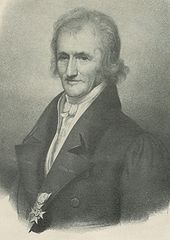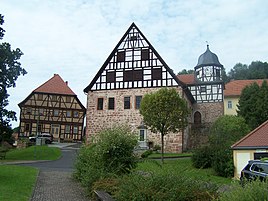Zillbach (Schwallungen)
|
Zillbach
Community Schwallungen
Coordinates: 50 ° 42 ′ 15 ″ N , 10 ° 17 ′ 47 ″ E
|
|
|---|---|
| Height : | 337 (330-350) m above sea level NN |
| Residents : | 461 (Jan 10, 2015) |
| Incorporation : | April 1, 1992 |
| Postal code : | 98590 |
| Area code : | 036848 |
|
Location of Zillbach in Schwallungen
|
|
|
Hunting Lodge and Church (2017)
|
|
Zillbach is a village with about 400 inhabitants and belongs to the municipality of Schwallungen in the district of Schmalkalden-Meiningen ( Thuringia ).
geography
location
The place Zillbach is located in the northwestern part of the district, about ten kilometers (as the crow flies ) west of the city of Schmalkalden and about 17 kilometers northwest of the district town of Meiningen . Zillbach is located on a plateau of the Vorder Rhön near the Werra Valley .
Mountains and elevations
The highest elevations are the Oberer Vogelherd ( 464.9 m above sea level ), the Wasunger thicket ( 453 m above sea level ), the man height ( 450.3 m above sea level ), the Thistle head ( 440.4 m above sea level ) and the place at the Pirschhaus Zehn Buchen ( 448 m above sea level ). Most of these mountains and elevations are reforested through afforestation.
Waters
The eponymous Zillbach has a total length of about six kilometers. It rises on the outskirts of Zillbach, flows in an easterly direction and flows into the Werra when it swells . The Zillbach was also used intensively through the creation of fish ponds and as mill water.
history
The area where it is today was first mentioned as a forest district in documents such as the sales letter of the Frankenstein possessions to the Counts of Henneberg in 1330. The earliest mention and thus the basis of the local jubilee in May 2010 was a transcription of the place name on March 17, 1185 in the spelling "Czyllbach".
According to the Henneberg documents, this forest area was leased from 1461 to 1505 by two Hessian glassmaker families (glassmaker family Rattig and Cunz Gunckel ) to set up a forest glassworks . Since then, the place has belonged to the Hennbergian office Wasungen . The oldest family of guesthouses, the Mandel, from sacrificemann / Mandel, which is known to be the inn "Zur schwarzen Henne" after Count von Henneberg, also dates from this time.
The forests cleared by the glassmakers after a few decades favored the construction of a hunting lodge , which was built by Georg Ernst von Henneberg-Schleusingen in 1543 and existed until 1759. It was described as a circular, tower-like structure and made a very defensive impression on visitors. Around the main building, which is surrounded by a protective wall, additional farm and warehouse buildings were built.
According to the inheritance treaties with the dukes of Saxony , the territories of the Henneberg counts fell under the joint administration of the Ernestine and Albertine lines in 1583. When the Henneberg inheritance was actually divided in 1660, the dukes of Saxe-Weimar and Saxe-Gotha had to grapple with the amount of land that fell. On the basis of a recess built in 1661 , the woods were left to the Weimar family. At that time they were divided into 5 forests: the Zillbacher, Schwallunger, Wasunger, Stepfershäuser and Ober-Forst. When the country was divided within the Weimar Princely House, Zillbach came to the Eisenach line and was assigned to the Lichtenberg office (rear court). The hunting-loving Duke Johann Georg I from Eisenach made Marksuhl his place of residence from 1662 to 1672, from there he visited the hunting castles built in the vicinity at Ruhla, Eisenach and Zillbach.
In the vicinity of the remote Zillbach Castle, the first houses for farmers, servants and forest workers were built from 1693 with the permission of Duke Johann Georg von Sachsen-Eisenach . This settlement required an agricultural area - around 600 acres of forest had been cleared by 1751. The Duke allowed the construction of further houses - as semi-detached houses, they cost 100 guilders. From 1784 this settlement was called the Colonie des Kammergut and was supplemented by other buildings. In 1790 the current castle was rebuilt. After the initial successes, agricultural yields had declined rapidly and led to increasing hardship and misery among the indebted village population. Several residents acquired a role model role for the place by introducing additional manual jobs - such as the clog-making trade, cork and meerschaum carving. However, this trade later perished in the village when it moved to Ruhla . In 1879, based on the census of 1875, statistical information on the place, now part of the Grand Duchy of Saxony-Weimar-Eisenach , was published.
At that time Zillbach belonged as an exclave in the Meiniger Duchy to the district court district of Kaltennordheim and this year had 85 houses with 476 inhabitants. The size of the fields was 204.8 ha of which farms and gardens 11 ha, meadows 61.4 ha, arable land 119.0 ha. The municipality's own forest was only 3.5 ha. The area of ponds, streams and rivers was 0.8 ha, paths, drifts, wasteland and fruit tree plantations accounted for 8.4 ha. The Zillbach area also included the grand-ducal forest district with a total area of 2659.6 ha as well as the Schwallung forest, also an exclave at the time, which was co-administered by the Zillbach Forest Inspection a size of 1755 ha. The village had a herd of 4 horses, 141 cattle, 18 sheep, 56 goats and 49 pigs and 7 beehives.
Personalities

- Heinrich Cotta (1763–1844), one of the founders of forest science , was born here and founded his first educational institution here. In the immediate vicinity of the village he created a unique forest area with around 200 different tree species that can still be seen today.
- Christian Friedrich Gottlieb Thon (1773–1844), author, was a rent officer and forestry commissioner in Zillbach
- Johann Christian Friedrich Meyer (1777-1854), forest scientist, was a teacher at the Cotta'schen Forstlehranstalt
- Bernhard von Cotta (* 1808 in the forester's house Kleine Zillbach; † 1879 in Freiberg ); Son of Heinrich Cotta, geologist and mining scientist.
- Karl Friedrich Schwanitz (1823–1903), German judge and scholar
- Hugo Bach (1872–1950), judge in German South West Africa, ministerial official
- Magda Langenstraß-Uhlig (1888–1965), German painter
Economy and Infrastructure
Established businesses
In Zillbach there is a restaurant, a software company, a nail studio, cosmetics and foot care, a retirement home, a stonemason, a carpenter and an organic farmer.
Culture and sights
The town of Zillbach celebrated its 825th anniversary with a week of festivities in May 2010.
Today's hunting lodge Zillbach is a simple baroque building and is one of the palace buildings of the Dukes of Saxony-Eisenach . Heinrich Cotta established a forestry school in Zillbach in 1795, which Johann Wolfgang von Goethe also visited several times in an official capacity. There is a forest history museum in the center of the village.
The St. Hubertus Church is also worth seeing. It was set up in 1718 by the Duke of Eisenach in the old castle building from 1594 after complaints from the ZIllbacher about too long church paths.
Sports
The village has, among other things, a sports club with a football team that actively participates in football matches in the area.
literature
- Hartmut Burkhardt (ed.): The forest village Zillbach and Heinrich Cotta . (Notices from the State Institute for Forests and Forestry, special edition). State Institute for Forests and Forestry, Gotha 1997, DNB 953062589 .
- Ulrich Knothe (Red.): The 800 year old Zillbach and his heritage. An anthology of speeches and essays on Heinrich Cotta, Bernhard von Cotta and Carl Emil Diezel . Kulturbund der GDR, district management Suhl, and district board of the Society for Nature and Environment , Suhl 1985, DNB 860494144 .
Web links
Individual evidence
- ↑ "Facts and Figures" on the Schwallungen community homepage , accessed on April 17, 2016.
- ↑ Highlight of the parade: 800 meters of history and present. (No longer available online.) In: Südthüringer Zeitung STZ, local page Schmalkalden, issue of May 25, 2010. Online magazine. Formerly in the original ; Retrieved May 28, 2010 . ( Page no longer available , search in web archives )
- ^ Johannes Mötsch: Community Henneberg Archives. Section VI . Ed .: State Archives Meiningen. Stock number 410106. Meinigen 2000, p. 635 .
- ^ Description of the Lichtenberg Office
- ^ Constantin Kronfeld: Thuringian-Saxon-Weimar History. Böhlau, Weimar 1878. (Regional studies of the Grand Duchy of Saxony-Weimar-Eisenach, T. 1, reviewed by: Ulrich Stechele)
- ^ C. Kronfeld: Regional studies of the Grand Duchy of Saxony-Weimar-Eisenach. Part 2. Weimar 1879, p. 84.
- ↑ Cheering, hustle and bustle, zammete and cheese. The start of the anniversary celebrations in Zillbach. (No longer available online.) In: Südthüringer Zeitung STZ, local page Schmalkalden-Meiningen online edition of May 21, 2010. Formerly in the original ; Retrieved May 27, 2010 . ( Page no longer available , search in web archives )


